Dell Studio 1737 User Manual
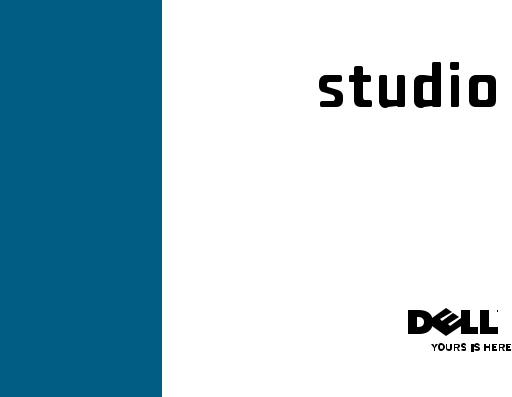
SETUP GUIDE


SETUP GUIDE
Model PP31L

Notes, Notices, and Cautions
 NOTE: A NOTE indicates important information that helps you make better use of your computer.
NOTE: A NOTE indicates important information that helps you make better use of your computer.
NOTICE: A NOTICE indicates either potential damage to hardware or loss of data and tells you how to avoid the problem.
 CAUTION: A CAUTION indicates a potential for property damage, personal injury, or death.
CAUTION: A CAUTION indicates a potential for property damage, personal injury, or death.
If you purchased a Dell™ n Series computer, any references in this document to Microsoft® Windows® operating systems are not applicable.
__________________
Information in this document is subject to change without notice. © 2008-2009 Dell Inc. All rights reserved.
Reproduction of these materials in any manner whatsoever without the written permission of Dell Inc. is strictly forbidden.
Trademarks used in this text: Dell, the DELL logo, MediaDirect, Wi-Fi Catcher, YOURS IS HERE, and DellConnect are trademarks of Dell Inc.; Intel, Pentium, and Celeron are registered trademarks and Core is a trademark of Intel
Corporation in the U.S. and other countries; Microsoft, Windows, and Windows Vista are either trademarks or registered trademarks of Microsoft Corporation in the United States and/or other countries.; Blu-ray Disc is a trademark of the Bluray Disc Association; Bluetooth is a registered trademark owned by Bluetooth SIG, Inc. and is used by Dell under license.
Other trademarks and trade names may be used in this document to refer to either the entities claiming the marks and names or their products. Dell Inc. disclaims any proprietary interest in trademarks and trade names other than its own.
January 2009 P/N F174H Rev. A01
Contents
Setting Up Your Studio Laptop 5
Before Setting Up Your Studio Laptop 5 Connecting the AC Adapter 6
Connecting the Network Cable
(optional) 7 Turning on Your Studio Laptop 8 Using the Wireless Switch 9 Windows Vista® Setup 9 Connecting to the Internet (Optional) 10
Using Your Studio Laptop 12
Right Side Features 14 Left Side Features 18
Computer Base and Keyboard
Features 23 Display Features 26
Media Controls 27 Removing and Replacing the Battery 28 Using the Optical Disc Drive 29 Software Features 30
Solving Problems 33
Network Problems 33 Power Problems 34 Memory Problems 35 Lockups and Software Problems 36
Using Support Tools 38
Dell Support Center 38 System Messages 38 Hardware Troubleshooter 40 Dell Diagnostics 40
3
Contents
Restoring Your Operating System 43
System Restore 43 Dell Factory Image Restore 44 Operating System Reinstallation 46
Getting Help 48
Technical Support and Customer
Service 49 DellConnect™ 49 Online Services 49 AutoTech Service 50 Product Information 51
Returning Items for Repair Under
Warranty or for Credit 51 Before You Call 52 Contacting Dell 53
Finding More Information and
Resources 54
4
Basic Specifications 56 Appendix 67
Macrovision Product Notice 67
Index 68

Setting Up Your Studio Laptop
This section provides information about setting up your Studio 1737 laptop and connecting peripherals.
Before Setting Up Your Studio Laptop
When positioning your computer, ensure that you allow easy access to a power source, adequate ventilation, and a level surface to place your computer.
Restricting airflow around your Studio computer may cause it to overheat. To prevent overheating ensure that you leave at least
10.2 cm (4 in) at the back of the computer and a minimum of 5.1 cm (2 in) on all other sides. You should never put your computer in an enclosed space, such as a cabinet or drawer when it is powered on.
CAUTION: Do not block, push objects into, or allow dust to accumulate in the air vents. Do not store your Dell™ computer in a low-airflow environment, such as
a closed briefcase, while it is running. Restricting the airflow can damage the computer or cause a fire.The computer turns on the fan when the computer gets hot. Fan noise is normal and does not indicate a problem with the fan or the computer.
NOTICE: Placing or stacking heavy or sharp objects on the computer may result in permanent damage to the computer.
5
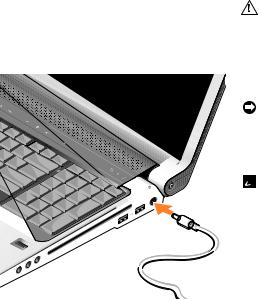
Setting Up Your Studio Laptop
Connecting the AC Adapter
Connect the AC adapter to the computer and then plug it into a wall outlet or surge protector.
6
CAUTION: The AC adapter works with electrical outlets worldwide. However, power connectors and power strips vary among countries. Using an incompatible cable or improperly connecting the cable to a power strip or electrical outlet may cause fire or equipment damage.
NOTICE: When you disconnect the
AC adapter cable from the computer, grasp the connector, not the cable itself, and pull firmly, but gently to help prevent damage to the cable.
 NOTE: Connect the power cord to the adapter firmly and ensure that the light on the adapter is on when you turn on power.
NOTE: Connect the power cord to the adapter firmly and ensure that the light on the adapter is on when you turn on power.
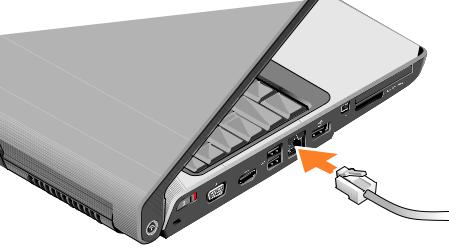
Setting Up Your Studio Laptop
Connecting the Network Cable (optional)
To use a wired network connection, plug in the network cable.
7
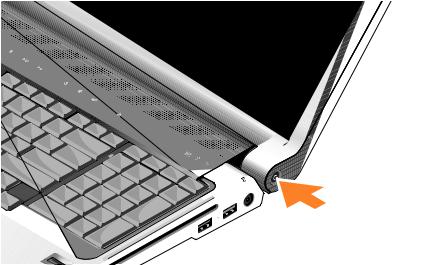
Setting Up Your Studio Laptop
Turning on Your Studio Laptop
8
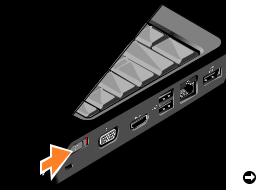
Using the Wireless Switch
To use wireless connections, make sure the wireless switch is in the “On” position.
Setting Up Your Studio Laptop
To turn on the wireless switch, slide it from the rear to the front of the computer until it clicks into place.
 - Off
- Off  - On
- On
Windows Vista® Setup
Your Dell computer is preconfigured with Windows Vista. To set up Windows Vista for the first time, follow the instructions on the screen. These steps are mandatory and may take up to 15 minutes to complete. The screens will take you through several procedures including accepting license agreements, setting preferences and setting up an Internet connection.
NOTICE: Do not interrupt the operating system’s setup process, doing so may render your computer unusable.
9

Setting Up Your Studio Laptop
Connecting to the Internet (Optional)
 NOTE: ISPs (Internet Service Providers) and ISP offerings vary by country.
NOTE: ISPs (Internet Service Providers) and ISP offerings vary by country.
To connect to the Internet, you need an external modem or network connection and an Internet service provider (ISP).
 NOTE: If an external USB modem or WLAN adapter is not a part of your original order, you can purchase one from the Dell website at www.dell.com.
NOTE: If an external USB modem or WLAN adapter is not a part of your original order, you can purchase one from the Dell website at www.dell.com.
Setting Up a Wired Internet Connection
If you are using a dial-up connection, connect the telephone line to the external USB modem (optional) and to the telephone wall connector before you set up your Internet connection. If you are using a DSL or cable/satellite modem connection, contact your ISP or cellular telephone service for setup instructions.
10
Setting Up a Wireless Connection
 4
4
 3
3
 2
2  1
1
1.Internet service
2.cable or DSL modem
3.wireless router
4.portable computer with wireless network card
See the documentation for your computer or router for more information about how to set up and use your wireless network.

Before you can use your wireless Internet connection, you need to connect to your wireless router. To set up your connection to a wireless router:
1.Save and close any open files, and exit any open programs.
2.Click Start  → Connect To.
→ Connect To.
3.Follow the instructions on the screen to complete the setup.
Setting Up Your Internet Connection
 NOTE: If you cannot connect to the Internet but have successfully connected in the past, the ISP might have a service outage. Contact your ISP to check the service status, or try connecting again later.
NOTE: If you cannot connect to the Internet but have successfully connected in the past, the ISP might have a service outage. Contact your ISP to check the service status, or try connecting again later.
 NOTE: Have your ISP information ready. If you do not have an ISP, the Connect to the Internet wizard can help you get one.
NOTE: Have your ISP information ready. If you do not have an ISP, the Connect to the Internet wizard can help you get one.
Setting Up Your Studio Laptop
1.Save and close any open files, and exit any open programs.
2.Click Start  → Control Panel.
→ Control Panel.
3.Under Network and Internet, click Connect to the Internet.
The Connect to the Internet window appears.
4.Select either Broadband (PPPoE) or Dial-up, depending on how you want to connect:
a.Choose Broadband if you will use a DSL, satellite modem, cable TV modem, or wireless technology connection.
b.Choose Dial-up if you will use an optional USB dial-up modem or ISDN.
 NOTE: If you do not know which type of connection to select, click Help me choose or contact your ISP.
NOTE: If you do not know which type of connection to select, click Help me choose or contact your ISP.
5.Follow the instructions on the screen and use the setup information provided by your ISP to complete the setup.
11
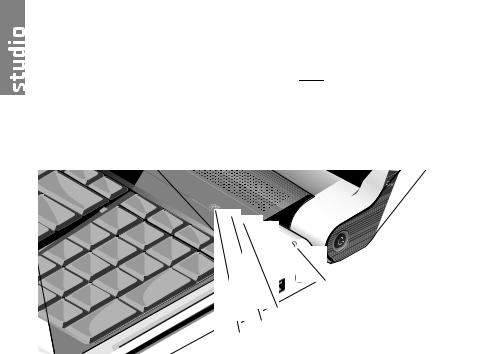
Using Your Studio Laptop
Your Studio 1737 has several indicators, buttons, and features that provide information at-a- glance and time-saving shortcuts for common tasks.
Device Status Lights
2
1
1

 WiFi status light – Turns on when wireless networking is enabled.
WiFi status light – Turns on when wireless networking is enabled.
See “wireless on/off switch” on page 22 to quickly turn all wireless communication on and off.
4
3
12

2

 Bluetooth® status light (optional) –
Bluetooth® status light (optional) –
Turns on when a card with Bluetooth wireless technology is enabled.
 NOTE: The card with Bluetooth wireless technology is an optional feature.
NOTE: The card with Bluetooth wireless technology is an optional feature.
To turn off Bluetooth wireless, right-click the bluetooth icon in the notification area of your desktop, and click Turn Bluetooth Adapter Off or see “wireless on/off switch” on page 22.
3

 Hard drive activity light – Turns on when the computer reads or writes data. A flashing light indicates hard drive activity.
Hard drive activity light – Turns on when the computer reads or writes data. A flashing light indicates hard drive activity.
 NOTE: To avoid loss of data, never turn off the computer while the hard drive activity light is flashing.
NOTE: To avoid loss of data, never turn off the computer while the hard drive activity light is flashing.
Using Your Studio Laptop
4

 Battery status light – Indicates the battery charging state.
Battery status light – Indicates the battery charging state.
If the computer is connected to an electrical outlet:
•Solid white – the battery is charging.
•Off – the battery is adequately charged. If the computer is running on a battery:
•Off – the battery is adequately charged or the computer is turned off.
•Solid orange – the battery charge is low.
•Flashing orange – the battery charge is critically low and you should either plug in the AC adapter or save and close your open documents and applications until you can.
13
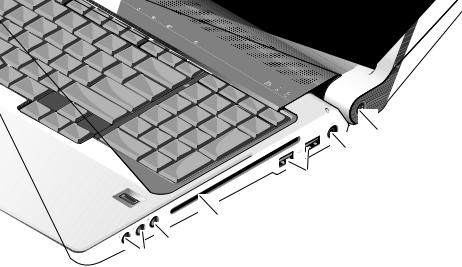
Using Your Studio Laptop
Right Side Features
6
5
4
3
2
1
14

 NOTE: Do not uses non-standard-size or shape discs (including mini-CDs and miniDVDs) or you will damage the drive.
NOTE: Do not uses non-standard-size or shape discs (including mini-CDs and miniDVDs) or you will damage the drive.
1

 Audio Out/ Headphone
Audio Out/ Headphone
connectors (2) – Connect to headphones, powered speakers, or sound systems. The audio signal is the same for both connectors.
2

 Audio In/ Microphone connector –
Audio In/ Microphone connector –
Connects to a microphone or input signal for use with audio programs.
Using Your Studio Laptop
3Optical Drive – Supports only standardsize and shape (12 cm) CDs, and DVDs. Ensure that the side with print or writing is facing upward when inserting discs.
For more information, see the Dell Technology Guide.
4

 USB 2.0 connectors (2) – Connect USB devices, such as a mouse, keyboard, printer, external drive, or MP3 player.
USB 2.0 connectors (2) – Connect USB devices, such as a mouse, keyboard, printer, external drive, or MP3 player.
5

 AC adapter connector – Attaches an AC adapter to the computer to power the computer and charge the battery when the computer is not in use. The AC adapter converts AC power to the DC power required by the computer.
AC adapter connector – Attaches an AC adapter to the computer to power the computer and charge the battery when the computer is not in use. The AC adapter converts AC power to the DC power required by the computer.
For more information, see “Connect the AC Adapter” on 8
15

Using Your Studio Laptop
6 Power button and light – Turns the power on or off when pressed.
Power button and light – Turns the power on or off when pressed.
NOTICE: If the computer stops responding, press and hold the power button until the computer turns
off completely (may take several seconds).
The light in the center of this button indicates the power state:
•Blinking white – the computer is in sleep state
•Solid white – the computer is in poweron state
•Off – the computer is switched off or in hibernate state
16
Using Your Studio Laptop
17
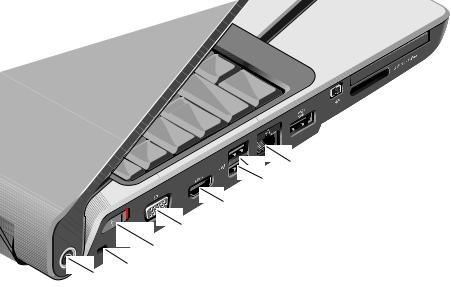
Using Your Studio Laptop
Left Side Features
7
6
5
4
3
2
1
18

1Dell Wi-Fi Catcher™ Network Locator button
Turn on the wireless switch and press this button for a few seconds to scan for wireless networks in your vicinity.
 NOTE: The Wi-Fi Catcher Network Locator light appears only when the computer is turned off and the wireless switch is configured in the system setup program (BIOS) to control Wi-Fi network connections.
NOTE: The Wi-Fi Catcher Network Locator light appears only when the computer is turned off and the wireless switch is configured in the system setup program (BIOS) to control Wi-Fi network connections.
 NOTE: The Wi-Fi Catcher Network Locator is enabled and configured for use when your computer is shipped to you.
NOTE: The Wi-Fi Catcher Network Locator is enabled and configured for use when your computer is shipped to you.
Using Your Studio Laptop
If the computer is turned off, the light in the center of this button indicates the searching state:
•Flashing white: Searching for network
•Solid white for 10 seconds then turns off: Network found
•Flashing white turns off after 10 blinks: No signal found
2Security cable slot – Attaches a commercially available antitheft device to the computer.
 NOTE: Before you buy an antitheft device, ensure that it works with the security cable slot on your computer.
NOTE: Before you buy an antitheft device, ensure that it works with the security cable slot on your computer.
19

Using Your Studio Laptop
3

 Wireless On/Off switch – Quickly turns Off or On all wireless devices such as WLAN cards and internal cards with Bluetooth wireless technology.
Wireless On/Off switch – Quickly turns Off or On all wireless devices such as WLAN cards and internal cards with Bluetooth wireless technology.
The wireless switch may be in the Off position when your computer is shipped to you. To turn the switch On, slide the switch toward the front of the computer until it clicks into place.
 - Off
- Off  - On
- On
 NOTE: This switch can be deactivated through Dell QuickSet or the BIOS (system setup program).
NOTE: This switch can be deactivated through Dell QuickSet or the BIOS (system setup program).
4


 VGA connector – Connects to video devices, such as a monitor or projector.
VGA connector – Connects to video devices, such as a monitor or projector.
20
5

 HDMI-Out connector – HDMI-Out (Hi-Definition Mutimedia Interface Out) connector carries outgoing data as uncompressed all digital signal to produce hi-definition video and audio. For example, it connects to a TV for both audio and video signals.
HDMI-Out connector – HDMI-Out (Hi-Definition Mutimedia Interface Out) connector carries outgoing data as uncompressed all digital signal to produce hi-definition video and audio. For example, it connects to a TV for both audio and video signals.
 NOTE: For a monitor, only the video signal will be read.
NOTE: For a monitor, only the video signal will be read.
6

 USB 2.0 connectors (2) – Connect to USB devices, such as a mouse, keyboard, printer, external drive, or MP3 player.
USB 2.0 connectors (2) – Connect to USB devices, such as a mouse, keyboard, printer, external drive, or MP3 player.
7

 Network connector – If you are using a cabled network signal, this connects your computer to a network or broadband device. The two lights next to the connector indicate status and activity for wired network connections.
Network connector – If you are using a cabled network signal, this connects your computer to a network or broadband device. The two lights next to the connector indicate status and activity for wired network connections.
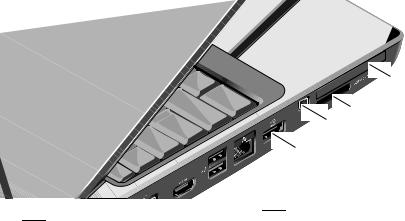
8

 eSATA/USB combo connector –
eSATA/USB combo connector –
Connects to eSATA compatible storage devices, such as external hard disk drives or optical drives. Also, supports USB devices, such as a mouse, keyboard, printer, external drive, or MP3 player.
Using Your Studio Laptop
11
10
9
8
9


 IEEE 1394 connector – Connects to high-speed serial multimedia devices that support IEEE 1394, such as some digital video cameras.
IEEE 1394 connector – Connects to high-speed serial multimedia devices that support IEEE 1394, such as some digital video cameras.
21

Using Your Studio Laptop
10 SD/MMC - MS/Pro
8-in-1 Media card reader – Provides a fast and convenient way to view and share digital photos, music, videos, and documents stored on the following digital media memory cards:
•Secure digital (SD) memory card
•Secure Digital Input/Output (SDIO) card
•MultiMedia Card (MMC)
•Memory Stick
•Memory Stick PRO
•xD-Picture Card
•Hi Speed-SD
•Hi Density-SD
 NOTE: Your computer ships with a plastic blank installed in the media card slot. Blanks protect unused slots from dust and other particles. Save the blank for use when no media card is installed in the slot. Blanks from other computers may not fit your computer.
NOTE: Your computer ships with a plastic blank installed in the media card slot. Blanks protect unused slots from dust and other particles. Save the blank for use when no media card is installed in the slot. Blanks from other computers may not fit your computer.
22
11

 ExpressCard slot – Provides support for additional memory, wired and wireless communications, multimedia, and security features. Supports both 54 mm and 34 mm ExpressCards.
ExpressCard slot – Provides support for additional memory, wired and wireless communications, multimedia, and security features. Supports both 54 mm and 34 mm ExpressCards.
 NOTE: Your computer ships with a plastic blank installed in the ExpressCard slot. Blanks protect unused slots from dust and other
NOTE: Your computer ships with a plastic blank installed in the ExpressCard slot. Blanks protect unused slots from dust and other
particles. Save the blank for use when no ExpressCard is installed in the slot; blanks from other computers may not fit your computer.
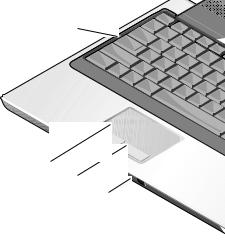
Computer Base and Keyboard
Features
1
2
3
4
Using Your Studio Laptop
1Caps Lock light – Turns on when using the Caps Lock key.
2Touch pad – Provides the functionality of a mouse to move the cursor, drag or move selected items, and right-click or left-click by tapping the surface.
It supports circular scrolling and zoom. To change the circular scrolling and zoom settings, double-click the Dell Touch
pad icon in the notification area of your desktop.
In the Scroll & Zoom Settings window, enable or disable scrolling, circular scrolling, or zoom, choose the scroll zone width and scroll speed.
3Touch pad buttons – Provide left-click and right-click functions like those on a mouse.
4Analog Microphone – If you do not have the optional built-in camera with dual microphones, this single microphone is used for conferencing and chat.
23

Using Your Studio Laptop
5 |
8 |
|
7 |
||
|
||
|
6 |
24
